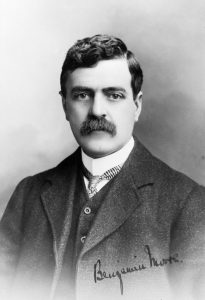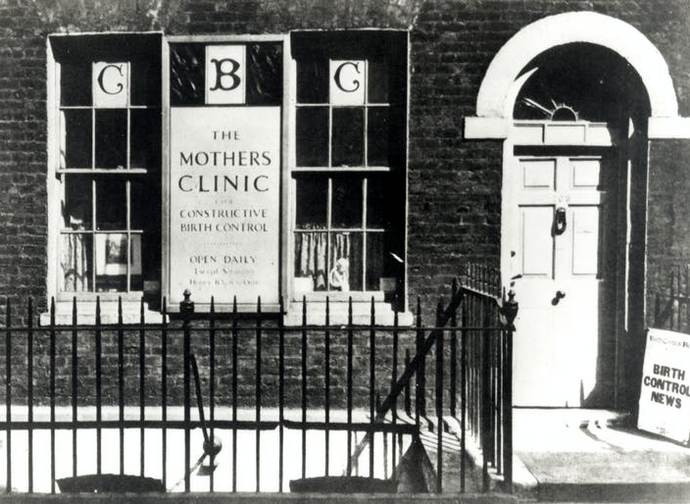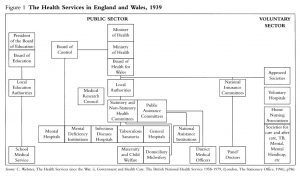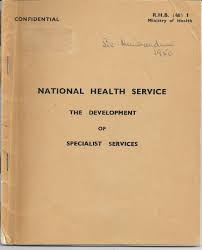Early history of NHS – 1900-1948
Like the 19th Century, the first half of the 20th Century focused on public health.
But the 1905 Minority Report on the Poor Law and Unemployed also called for a ‘state medical service’. The response to the report started with the National Insurance Act 1911 and the Cave Committee in 1921; showing the first signs of state funding of healthcare – to working men and voluntary hospitals respectively.
The formation of the Air Raid Precautions (ARP) Department in 1935 showed (albeit in preparation for war) that the state was willing to organise hospitals and ambulances into a single national system.
Thus the idea that the NHS started ‘out of the blue’ in 1948 based on the Beveridge Report is false. Beforehand, there had been a lot of public desire, some government will, and slow preparation for a nationalised health system. This started in the 19th Century and continued in the first half of the 20th Century.
The 1900s – 1930s
1900 Conservative & Liberal Unionist (The Marquess of Salisbury MP/Arthur Balfour MP) then Liberal Governments (Sir Henry Campbell-Bannerman MP)
1901. British Monarch. King Edward VII (1901–1910)
1902. Education. Midwives Act 1902. This created the Central Midwives Board, which was responsible for the registration of midwives, securing better training of midwives and the regulation of their practice. They were previously often untrained and unqualified; and it has been suggested that some practitioners were prostitutes who were reputedly paid in gin.
1903 First Tour de France
1903. Science/Clinical. Marie Curie (and husband) won Nobel Prize for Physics for discovering radioactivity. She was the first woman to win a Nobel Prize, and the only woman to receive two Nobel prizes, winning the Nobel Prize for Chemistry in 1911. Her discoveries led to xrays and the treatment of cancer with radiotherapy.
1905. Government. Royal Commission on the Poor Law and the Unemployed. The ‘Majority’ and ‘Minority’ reports released in 1909 criticised the duplication of health services provided by voluntary and Poor Law institutions, but their recommendations differed. In the Minority Report, Beatrice Webb (who co-founded the London School of Economics and Political Science and was a key member of the Fabian Society) called for a ‘state medical service’. This was one of the first proposals for a state-run health service. It was largely ignored,
1906 Liberal Government (Sir Henry Campbell-Bannerman MP/Herbert Henry Asquith MP)
1906 Einstein discovers Special Relativity; 1906-17 Russian Revolution; 1908 Model T Ford
1910 Liberal Government (Herbert Henry Asquith MP/David Lloyd George MP)
1910. Monarch. King George V (1910–1936)
1910. History. Origin of the phrase ‘NHS’. Dr Benjamin Moore was probably the first to use the words ‘NHS’ in The Dawn of the Health Age. He established the State Medical Service Association in 1912, replaced by the Socialist Medical Association in 1930.
 Dr Benjamin Moore
Dr Benjamin Moore
1911 Ernest Rutherford identifies the atomic nucleus
1911. Government. National Insurance Act 1911. Previously, systems of health insurance consisted of private schemes such as friendly societies or welfare societies. But in 1911, David Lloyd George (then Chancellor of the Exchequer, later Prime Minister) created a system whereby a small amount was deducted from weekly wages, supplemented by contributions from the employer.
Under this Act, all eligible working males could register with a GP. They could choose from a ‘panel’ of local doctors. GPs who took part in this scheme were called ‘panel doctors’ and received an annual ‘capitation’ fee; a funding mechanism still used today. This was a very important act and in some ways, the real ‘birth’ of the NHS. For the first time, central government finance was used to provide medical care for the people.
1914-18 World War I
1915 Einstein discovers General Theory of Relativity
1916 General Election cancelled because of WWI
1916. Union. Royal College of Nursing (RCN) – was founded as an association to unite trained nurses.
1918 Liberal Coalition then Conservative Governments (David Lloyd George MP/Bonar Law MP)
1918. Pandemic. Spanish Flu (January 1918 – December 1920) – was caused by the transmission of an avian influenza virus to humans, killing about 50 million people worldwide. It was followed by similar viral pandemics including Asian Flu (1957), Hong Kong Flu (1968), HIV/AIDS (1981+), Swine Flu (2009), Ebola (2013) and COVID-19 (2020+; WHO estimate over 15 million deaths by May 2022).
1919. Government. Ministry of Health. The First World War was a catalyst for social change with Lloyd George promising a land “fit for heroes to live in”. This included the creation of the Ministry of Health.
1919. Regulation. Nurses Registration Act 1919. This established a regulator for nurses, the General Nursing Council for England and Wales.
1920. Public Health. Dawson Report – suggested the organisation of medicine was insufficient to bring the advances of medical knowledge within the reach of the people. It proposed a linkage of hospitals into a single system, an early vision of the NHS.
1921. Government. Cave Committee inquiry into voluntary hospital finances – found that a high proportion of voluntary hospitals (321 of 565) were running deficits. They recommended that temporary government assistance should be provided to ensure the survival of voluntary hospitals. The government accepted the recommendation and made grants that eventually improved the state of hospital finances. This was the first state funding of hospitals, again a key building block of the idea of an NHS.
1921. Public Health. Public Health (Tuberculosis) Act 1921. Obliged county councils to provide sanatoria, care and after-care services for tuberculosis patients.
1921. Public Health. First birth control clinic was founded in London, following campaigns by the National Birth Control Council (NBCC).
 First birth control clinic, 61 Marlborough Road, Holloway, London
First birth control clinic, 61 Marlborough Road, Holloway, London
1922 Conservative Government (Bonar Law MP/Stanley Baldwin MP)
1922 Irish Civil War and Irish Free State forms; Howard Carter discovers Tutankhamen’s tomb; British Broadcasting Corporation (BBC) established
1923 Conservative then Labour minority Governments (Stanley Baldwin MP/Ramsay MacDonald MP)
1924 Conservative Government (Stanley Baldwin MP)
1924. Public Health. Royal Commission on National Health Insurance. The Commission’s ‘majority report’, in 1926, found the system effective and recommended its extension to dependents. Its ‘minority report’ found the involvement of industrial insurance companies detrimental to the expansion of public health and recommended provision through public funding.
1927 World population reaches two billion (now nearly 8 billion)
1927 United Kingdom of Great Britain and Ireland officially becomes the United Kingdom of Great Britain and Northern Ireland
1929. Government. Local Government Act 1929 – allowed local authorities to run services over and above those authorised by the Poor Laws.
1929 Labour Government (Ramsay MacDonald MP)
1929 Wall Street Crash, followed by Great Depression
1930. Union. Socialist Medical Association formed out of the State Medical Service Association. In his first presidential address in May 1931, Somerville Hastings (a Labour politician and surgeon) outlined the principles for a new type of medical service: preventive, universal, and without economic barriers. It became the Socialist Health Association in 1981.
1930. Public Health. Formal birth control services for married women. In July 1930, a Ministry of Health circular permitted local health authorities (LHAs) to provide birth control advice for married women through voluntary organisations that ran family health clinics, but only under circumstances where a further pregnancy would be detrimental to the health.
1931 National Labour Government (Ramsay MacDonald MP)
1931 Empire State Building completed
1934. Public Health. Milk in schools scheme. After the first Milk in Schools Scheme (MISS) was introduced in major cities during the late 1920s, 1934 saw an extension across England and Wales.
1934. Politics. Labour Conference (Southport). The party ratified a motion on the creation of an NHS by Somerville Hastings.
1935 Conservative then National Governments (Stanley Baldwin MP/Neville Chamberlain MP/Winston Churchill MP)
1940 General Election cancelled due to WWII
1936 Monarch. King George VI (1936–1952)
1935. Government. Pre-war planning for a national hospital service. The Air Raid Precautions (ARP) Department was established to supervise civil defence measures. As part of this function, it became responsible for the planning and organisation (at a local level) of a national hospital and ambulance service, which could deal with air raid casualties in the event of another war.
 Air Raid Precautions poster
Air Raid Precautions poster
1938. Union. British Medical Association (BMA) – published a pamphlet: ‘A General Medical Service for the Nation’. It described how health insurance should be extended to the dependents of wage-earners.
 Health services were quite complicated before 1939
Health services were quite complicated before 1939
1939-45 World War II
1939. Government. Emergency Medical Service (EMS). At the outbreak of war, central government took over voluntary and municipal hospitals establishing the Emergency Medical Service. Doctors and nurses were, for the first time, employed by a centralised state-run system. Oddly, healthcare often advances in war.
The 1940s
1942. Government. Beveridge Report. An Inter-Departmental Committee led by Sir William Beveridge published the Beveridge Report calling for a comprehensive system of social insurance ‘from cradle to grave’. It proposed all working people should pay a weekly contribution to the State, with benefits to be paid to the unemployed, the sick, the retired, and the widowed. This is one of the most important documents in the social history of the UK and might be considered the manifesto of the Welfare State.
1945 Harry S. Truman orders the atomic bombings of Hiroshima and Nagasaki (6 and 9 August)
Japan surrendered on 2 September, ending the war
1946 (July). Government. National Health Service Act 1946 published.
1947. Government. National Health Service (Scotland) Act 1947. Passed responsibility for the NHS in Scotland to the Secretary of State for Scotland.
1948 World Health Organization (WHO) founded
1948 (January). Management. ‘The development of specialist services’ – RHB(48)1 – is amongst the most important early planning documents in the NHS. This was a plan for specialised services (i.e. in hospitals). It was issued in January 1948 – in other words before the NHS began.
 RHB (48)1 – The Development of Specialist Services
RHB (48)1 – The Development of Specialist Services
1948 (July). Creation of the NHS. Following WWII, Britain’s first majority Labour government, led by Clement Attlee, formulated plans for a comprehensive Welfare State. A free at point-of-delivery NHS was the cornerstone of these plans.
The chief architect of the NHS was Labour Minister of Health, Aneurin Bevan. On 5 July, he launched the NHS at Park Hospital in Manchester (Trafford General Hospital).
It nearly did not happen. Famously, the BMA voted against it just before its birth. A Polish Diamond Merchant called Max Ryba identified Jewish and East European doctors who persuaded many GPs.
1949 Arab-Israeli War and Berlin Blockade begin
1949 NATO forms and Soviet Union tests the atomic bomb
1949 George Orwell publishes Nineteen Eighty-Four
Thus the NHS was born into an unstable and vulnerable world.
Other resources
The Health Foundation have an extremely good timeline here.
The Nuffield Trust has a detailed history of the NHS here and timeline here.
The BBC has historical charts here.
This video that describes healthcare in the UK before the NHS:
https://www.youtube.com/watch?v=ps0jHetKHd0&t=5s
Last Reviewed on 28 January 2024
